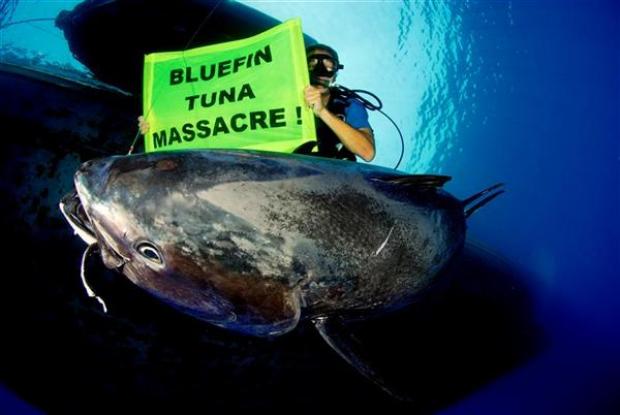An ex-bluefin tuna found during the Rainbow Warrior's previous visit to the Mediterranean in 2007 © Greenpeace/Care
Imagine you are an Atlantic bluefin tuna. You've been out at sea most of the year in cooler waters, feeding away and generally getting on with being a big ol' fish at the top of your food chain. You have not a care in the world, save the occasional orca or shark scare.
Then spring is sprung, and the urge takes you. Forces you don't really understand compel you to head back to warmer waters, and a certain key place, sacred to you bluefin. The bluefin equivalent of a romantic dinner and some subdued lighting is a sheltered warm sea, and conditions have to be perfect, or it ain't happening. But even that's not enough. Because of the, er, messy, way most fish reproduce, they congregate together, and only release sperm and eggs when the time and the temperature is right: 23 degrees Celsius. It's the perfect temperature for a bluefin love-in.
Atlantic bluefin, like many other animals, are very particular when it comes to getting frisky. And as anyone who knows anything about saving creatures who are on the brink of extinction will tell you, protecting their habitat and allowing them to breed successfully is the key to starting to stop the decline. That's as true of bison and pandas as it is of bluefin. Bluefin, being hugely migratory, aren't as easy to breed in captivity as some other animals. That makes protecting the areas important to them in the wild so important. And it's why I keep harping on about them.
The best known example is the seas around the Balearic Islands. To most of us these islands are a holiday haven for hordes of European tourists, and one of the few places you can find somewhere proudly claiming to serve ‘British' or ‘German' cuisine. To the Atlantic bluefin, this area is vital. When the time and temperature are right, fertilised eggs hatch into baby bluefin and this is their nursery. They will then float in the plankton, and hide amongst weeds until they're big enough to hold their own.
So - if you want to protect bluefin, you should protect the Balearics (and the Sicilian Channel, and the Gulf of Mexico too, for starters...). At the very least you should be protecting these nursery grounds from large-scale fishing, targeting the very fish that come here to breed.
That's why our ship the Rainbow Warrior is currently in the Mediterranean, her crew ready to confront those practicing one of the most irresponsible and destructive fishing operations in the world. Just a few weeks ago, the Convention on International Trade in Endangered Species (CITES) passed on the golden opportunity to place a ban on the trade in Atlantic bluefin, a ban which could have helped steer the crashing bluefin stocks away from extinction. And the science is sound, the rationale clear. It makes sense to anyone you tell it to - whether they want to save bluefin as a species, or as a future fishery.
So why hasn't it happened? The Balearic bluefin sanctuary (described here in a Spanish newspaper) has been proposed and endorsed by a number of NGOs, including Greenpeace. It has been backed by the regional government of the Balearics. Heck, it's even been supported by Mitsubishi Corporation, the largest trader in Mediterranean bluefin. But as yet, the government of Spain (not known as the best friend to the fish, it's true...) hasn't agreed.
It's yet another scandal in a sea full of them. How come it's okay for purse-seiners around the Mediterranean to wait and pounce on an endangered species just when they come together to breed? Why are our governments defending the vested fishing interests instead of the fish?
For an Atlantic bluefin tuna, answering that natural call to mate has never been so crucial.




